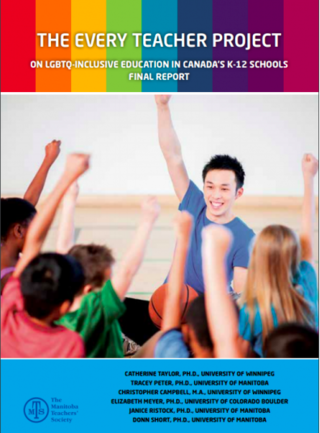Gender
LGBTQ Inclusion in Elementary Schools: What Teachers Can Do
Advice to build confidence and knowledge to support all kids and families.
Posted December 7, 2018
In 1996, the film “It's Elementary: Talking About Gay Issues in School” was released, showing teachers in kindergarten through fifth grade leading thoughtful and rigorous lessons about gay and lesbian people and families. It was a ground-breaking film that offered specific ideas and models about how to create schools that will be more welcoming and affirming of kids and families of all gender identities and sexual orientations.
However, even 20 years later LGBTQ topics in elementary schools are still seen as controversial—even though we know visibility and access to accurate information is essential to healthy identity development for all people. This post aims to provide elementary teachers resources and information to strengthen their practices as well as inform parents and administrators that this is important and valuable content in an elementary curriculum.
I worked with colleagues in Canada to develop a survey of teachers’ attitudes and experiences with what we called “LGBTQ-inclusive education” but what I generally refer to as practices that are inclusive of gender and sexual diversity or GSD-inclusive education. As part of this study, we wanted to understand how elementary educators were doing this work. In light of recent data showing continued hostility in schools towards LGBTQ youth (GLSEN 2017 NSCS), and suicides by young children for being gay, this continues to feel like urgent and important work.
In our recently published article, “Elementary teachers’ experiences with LGBTQ-inclusive education: Addressing fears with knowledge to improve confidence and practices” we share what we learned about elementary educators and how this might help others working to make their schools and classrooms more welcoming to all students and families, particularly those who are part of the LGBTQ community. We found that most teachers approved of LGBTQ-inclusive education (81% elementary, 88% secondary), but elementary educators who worked with younger children were less likely to report feeling “comfortable” teaching about the topic. Only 45% of kindergarten teachers said they’d be comfortable, compared to 64% of 5th-grade teachers, whereas 80% of secondary teachers were comfortable with the topic.
Elementary educators were also less likely to report participating in GSD-inclusive efforts at their schools than secondary educators (22% vs. 47%) and 20% of all participants reported that their “students are too young” to discuss LGBTQ topics in their curriculum. The most common barrier teachers described to GSD-inclusive education was the age of their students. A few teachers either indicated that they did not feel LGBTQ topics were appropriate for their students because of their age, or that they wanted to address these issues at an “age-appropriate level.” Others who mentioned students’ ages said LGBTQ issues aren’t an “issue in their classroom,” or that “sexual content is not age-appropriate for my students.” More data from this part of the research is available in the Every Teacher Project Final Report.

In light of these concerns, we hope to share suggestions that would improve teachers’ knowledge and confidence to be more inclusive in their teaching for students of all ages. There are great resources already developed that teachers can adapt without having to start from scratch. A few ideas we suggest starting with are:
- Teach a Welcoming Schools lesson plan on family diversity. One of these lessons, “What is a family” invites teachers to generate ideas from students about who is in their family and can be paired with reading texts that include diverse family structures
- Read some of the texts and lessons presented in Reading the Rainbow, a wonderful book published in 2018 about literacy education in elementary classrooms that includes ideas for text selection, discussion questions, and classroom activities.
- Choose a Teaching Tolerance lesson from their searchable database for your grade that addresses: gender stereotypes, definitions of community, immigration stories, media literacy activities, including art and LGBTQ rights.
- Connect with local education and advocacy groups like GLSEN or PFLAG to learn about the resources they provide and the work they are doing in your state.
- Read Gender, Your Guide, a 2018 book which is a very accessible resource to help you better understand gender diversity and be more affirming in everyday interactions with students, parents, and colleagues.
- Learn about local laws and policies regarding LGBTQ-inclusion in schools. GLSEN provides interactive maps.
- Download the Every Teacher Project Recommendations Toolkit based on findings from this survey. Includes recommendations for teachers’ organizations, government officials, school districts, teacher preparation programs, and religiously affiliated schools. The appendices include specific law and policy information for Canadian educators as well as resources for GSAs (Gender and Sexuality Alliances/Gay-Straight Alliances) and other school-wide programming ideas.


